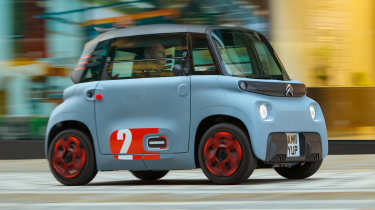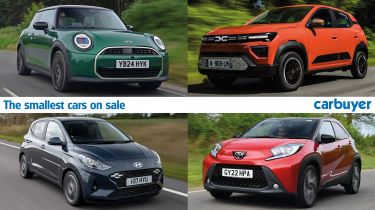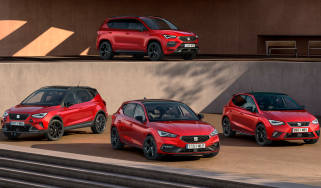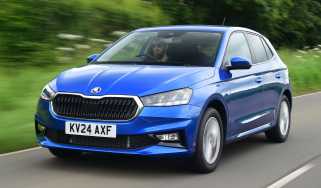Citroen Ami hatchback review


On the winding narrow streets of Britain, small cars have always been a popular choice for drivers seeking efficiency, manoeuvrability and a bit of fun behind the wheel. Whether you're navigating tight city streets, parking in small spaces, or simply looking to save on fuel, the smallest cars on sale can make urban driving that little bit more convenient.
But don’t assume that a small car means compromised comfort or lack of features; today, even the smallest cars are more capable and better-equipped than ever, offering impressive safety features, advanced tech, and surprisingly good motorway performance. A compact design is perfect for urban environments where space is at a premium, but most small modern cars can tackle the odd long journey without an issue.
What’s more, buyers now have a choice of several small electric cars, some of which are no more expensive than their petrol alternatives. These electric options combine the convenience of compact size with the benefit of zero-emissions motoring, making them an attractive choice for drivers who want to reduce their carbon footprint without having to haul around a big electric SUV.
So, what do we mean when we say a car is one of the smallest on sale? Cars have been growing in recent years, but every model on this list is less than four metres from bumper to bumper, and the shortest is well under three metres in length. That means they should fit in any garage or parking space with room to spare.
Keep reading to find out the very smallest cars you can buy today. For a more general look at our favourite small cars, you can read our list of the 10 best city cars.
Read on for our list of the 10 smallest cars currently on sale in the UK.
If small size is truly your only priority and you’re not concerned about speed, range or carrying any luggage, the Citroen Ami could be just the car you’re looking for. At just 2,410mm long, it’s comfortably the smallest car you can buy in the UK – although calling it a ‘car’ at all is slightly cheating.
The Citroen Ami is technically not a car, but a quadricycle. This means that drivers as young as 16 can pilot it around city streets, as long as they hold a motorcycle licence. With a tight 7.2-metre turning circle and compact dimensions, it’s incredibly easy to manoeuvre. Don’t expect to go too far or fast though, because the Ami’s 46-mile range and 28mph top speed match its puny size.
Despite its small size, the Ami offers reasonable practicality with a compact interior, which can seat two people thanks to its boxy shape. There are also plenty of cubby-holes scattered around to store any items you may pick up on a day out. If you don’t fancy carrying a friend, you can opt for the ‘cargo kit’ which swaps the passenger seat for a larger storage area.
| Pros | Cons |
|
|
Find the latest new and used Citroen Ami deals on our sister site Auto Express
It may be over 16 years old now, but few cars today offer the retro-chic that oozes from the Fiat 500. Measuring 3,571mm from end to end means it provides the compact dimensions vital for parking in Milan or Manchester. Inside, it’s surprisingly roomy with (just) enough space for four adults, although the lack of a five-door model hampers practicality. Boot space isn’t amazing but its 185 litres of space grows to 550 litres when you fold the back seats – just enough for a city break
With the wheels pushed right out into the corners of the car, and great visibility, it’s an easy car to park. And a ‘city’ mode makes the steering really light so that driving into tight spaces is a cinch. The little 500 is powered by a 1.0-litre mild-hybrid petrol engine that produces 68bhp and can deliver around 60mpg, but a separate electric model is also sold alongside it for drivers after the lowest possible running costs. While it looks similar, the EV is based on a different platform and is actually around 60mm longer.
| Pros | Cons |
|
|
Find the latest new and used Fiat 500 deals on our sister site Auto Express
The Kia Picanto first launched in 2004 when the South Korean car maker was yet to reach the popularity it has today. Twenty years later, in its latest generation, the Picanto continues to offer everything that small-car buyers need at an affordable price in what’s become a fiercely contested market.
The Picanto gets a high-quality cabin and is well equipped as standard, with Bluetooth, electric windows and 14-inch alloy wheels. For drivers who want to stay connected, it’s worth stepping up from the base model ‘2’ to the ‘3’, which adds a better infotainment system. As with all other Kias in the range, the Picanto also comes with a seven-year warranty. The new facelifted Picanto is now available to order, bringing the brand’s latest design language to the popular city car.
| Pros | Cons |
|
|
Find the latest new and used Kia Picanto deals on our sister site Auto Express
Leapmotor is a new entrant in the affordable electric car market, and it’s already making a splash with the T03. Not only is it one of the smallest cars on sale today, it’s also one of the cheapest, costing from under £16,000. While that may be twice as much as the Citroen Ami above, the Leapmotor is a far more usable machine and could be the ideal city runaround for buyers on a budget.
We imagine few readers will have heard of Leapmotor before, but the young Chinese brand has the backing of Stellantis, so buyers should receive the same aftersales support as Citroen, Peugeot and Vauxhall customers. Even with the T03’s dinky dimensions, Leapmotor has squeezed in a 37kWh battery, which is good for up to 165 miles of range – plenty for a city car. It’s surprisingly adept on the motorway, too, and the standard kit list puts pricier city cars to shame. If you’re looking for an upmarket cabin or a sporty drive, you won’t find it here, but the T03 is still a lot of small car for the money.
| Pros | Cons |
|
|
Find the latest new and used Leapmotor T03 deals on our sister site Auto Express
The smallest car in Hyundai’s range is also one of the smallest on sale in the UK, at 3,670mm long and 1,680mm wide. Inside and out, the latest i10 is the most stylish yet and is finished to a remarkably high standard despite its low price. There’s also plenty of space for five people, plus 252 litres of boot space. Buyers have a choice between 1.0 or 1.2-litre petrol engines, both of which work well around town, while the latter is our pick for anyone who regularly drives in the countryside or on the motorway.
The i10 might be one of the smallest cars you can buy, but it has more technology and interior space than ever before. Combine those qualities with improved driving dynamics and Hyundai’s five-year/unlimited-mileage warranty, and you have a car that’s well worthy of consideration.
| Pros | Cons |
|
|
Find the latest new and used Hyundai i10 deals on our sister site Auto Express
While it’s certainly city-car sized, the Suzuki Ignis looks like an SUV that’s shrunk in the wash. That chunky styling brings a handy raised ride height, a tall, boxy cabin and even the option of four-wheel-drive, meaning it can cope with much more than just congested city streets. Thanks to its box-like shape, the Ignis can easily carry four adult passengers and their luggage too.
All models come with a 1.2-litre mild-hybrid engine with enough grunt for nipping through traffic in town. Take the Ignis onto the motorway and it’s not as quiet or comfortable as some of the other cars in this list, but front-wheel drive models return decent fuel economy.
If a small SUV like the Renault Captur isn’t quite within your budget or you’re looking for something even tinier, the Ignis is your best – and probably cheapest – alternative.
| Pros | Cons |
|
|
Find the latest new and used Suzuki Ignis deals on our sister site Auto Express
The original Aygo was a small affordable city car favourite for quite some time, but Toyota has since replaced it with the slightly larger Aygo X. This takes the old recipe and adds a touch of SUV styling and a higher ride height to match. It’s still Toyota’s smallest car and one of the smallest cars on the market, but feels a little more contemporary than the Aygo it replaces.
Higher entry-level pricing for the Aygo X means it’s no longer such an enticing prospect for first-car buyers, but its raised ride height makes it better suited to absorb the impact from pothole-filled UK roads – a trait many buyers will be willing to pay for. The Aygo X is only available with one 1.0-litre petrol engine, though, which may not appeal if you’re looking for an electric or hybrid option.
| Pros | Cons |
|
|
Find the latest new and used Toyota Aygo X deals on our sister site Auto Express
If it’s a tiny electric car you’re after, and the Citroen Ami is just too primitive, the Dacia Spring could be the car for you. While not festooned with luxury features, the Spring has a few key things that the Ami doesn’t – notably, space for four, a decent boot, and a 140-mile range. It’ll even do 78mph, allowing it to keep up with traffic on fast roads should you venture outside of the city. Despite costing twice as much as the Ami, the Dacia Spring is hardly expensive, and it really feels like twice the car.
Dacia has kept the price of the Spring low by fitting a relatively small 27kWh battery – that’s not much bigger than the batteries fitted to some modern plug-in hybrids. As a result, it only takes around five hours to top up the battery via a home charger – the main method that Dacia expects customers to charge the Spring. Even the interior is surprisingly nice for a car of this price point, with top-spec models getting a crisp 10-inch infotainment touchscreen.
| Pros | Cons |
|
|
Find the latest new and used Dacia Spring deals on our sister site Auto Express
On paper, the Hyundai Inster looks a little expensive compared to some rival electric city cars like the Dacia Spring and Leapmotor T03, but it has a few things going in its favour. It’s a bit bigger for a start, meaning you get a much roomier cabin with a pair of usable rear seats. For higher trim levels, these rear seats slide back and forth, meaning you can prioritise passenger or boot space as you see fit.
But the Inster is still a small car at the end of the day, making it ideal for navigating through urban areas. The ride may be a bit firm at low speeds, but it has the refinement and composure of a bigger car once you’re up and running – something that can't be said about the Dacia Spring. All models get over 200 miles of range, beating its rivals, while the cabin feels upmarket and comes with all the kit you need. It’s a solid city car and well worth considering against the Dacia and Leapmotor, as well as our favourite small electric car, the Citroen e-C3.
| Pros | Cons |
|
|
Find the latest new and used Hyundai deals on our sister site Auto Express
If the Dacia Spring trades on value-for-money, then the new MINI Cooper is all about style. Reinvented for the electric age, MINI’s latest supermini packs fresh EV tech into a compact three-door body that’s no bigger than the old car. It wears a cleaner, simpler design for this generation, along with a totally revamped interior with an eye-catching circular infotainment screen. Getting into the rear pair of seats is a bit tricky, but once you’re in, there’s an impressive level of space. Thankfully, MINI has fitted a pair of ISOFIX points to the front passenger seat to make fitting a child car seat a bit easier.
Electric not your thing? MINI offers the Cooper with a petrol engine, although it’s technically similar to the old MINI Hatch under the skin. You get the same snazzy exterior and interior styling as the EV, but with a choice of 1.5-litre and 2.0-litre petrol engines. No matter which version of Cooper you pick, it’s a hoot to drive and makes for an excellent urban runaround.
| Pros | Cons |
|
|
Find the latest new and used MINI Cooper deals on our sister site Auto Express
Use the table below to compare the starting price, length and Carbuyer score of the 10 smallest cars above.
| Smallest car ranking | Make and model | Priced from | Length | Carbuyer rating (out of 5) |
| 1 | Citroen Ami | £8,000 | 2,410mm | 3.3 |
| 2 | Fiat 500 | £17,000 | 3,751mm | 3.3 |
| 3 | Kia Picanto | £16,000 | 3,605mm | 4.2 |
| 4 | Leapmotor T03 | £16,000 | 3,620mm | 3.8 |
| 5 | Hyundai i10 | £16,000 | 3,670mm | 4 |
| 6 | Suzuki Ignis | £18,000 | 3,700mm | 3.7 |
| 7 | Toyota Aygo X | £17,000 | 3,700mm | 3.8 |
| 8 | Dacia Spring | £15,000 | 3,701mm | 4 |
| 9 | Hyundai Inster | £23,000 | 3,825mm | 4.3 |
| 10 | MINI Cooper | £25,000 | 3,876mm | 4 |


New Smart #5 Brabus is a 637bhp far cry from the brand’s city car past

Skoda Fabia review – a great-value, practical supermini


